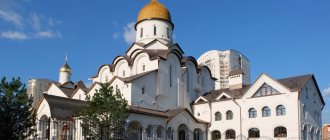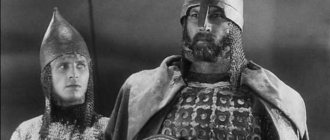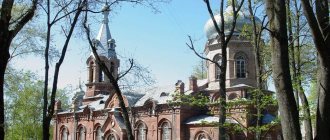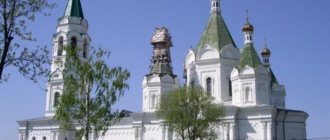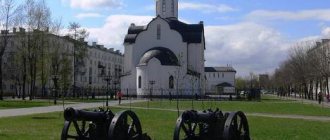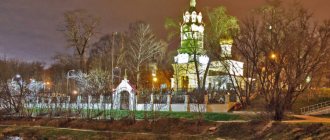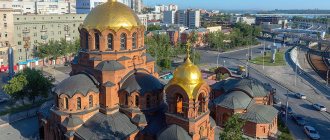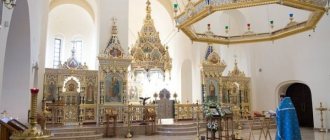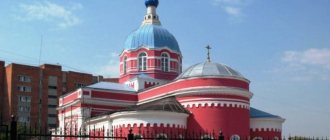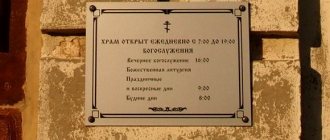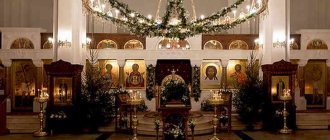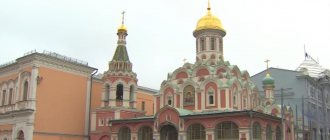This term has other meanings, see Alexander Nevsky Cathedral.
| Orthodox church | |
| Alexander Nevsky Cathedral | |
| Cathedral in the name of the Holy Blessed Grand Duke Alexander Nevsky | |
| Alexander Nevsky Cathedral, 1921 | |
| 55°46′36″ n. w. 37°35′32″ E. d.HGЯOL | |
| A country | Russia |
| City | Moscow |
| Confession | Orthodoxy |
| Architectural style | Neo-Russian |
| Author of the project | Alexander Pomerantsev and Viktor Vasnetsov |
| Construction | 1911-1917 |
| Key dates | |
| |
| Status | lost |
| State | lost |
| Media files on Wikimedia Commons | |
Alexander Nevsky Cathedral
- the largest in the series of Alexander Nevsky Cathedrals of the Russian Empire, the second largest historical temple in Moscow after the Cathedral of Christ the Savior. It was erected in 1913-1917 on Miusskaya Square in Moscow in memory of the liberation of peasants from serfdom. Construction, begun with donations collected throughout Russia, was not finally completed by 1917, but services were held in the consecrated chapels from 1915 to 1920. It was dismantled in the 1950s[1].
History[edit | edit code]
Construction initiative[edit | edit code]
Among the initiators and enthusiasts of the construction of the cathedral in honor of the heavenly patron of the emperor, who signed the manifesto on the abolition of centuries-old serfdom on February 19, 1861, were the publicist, publisher and historian Mikhail Pogodin, Moscow archaeologist and artist Dmitry Strukov and others[2][3]. On June 5, 1861, at the Chudov Monastery, a committee was Supremely approved to accept and store offerings for the construction of a temple in Moscow in the name of the holy noble prince Alexander Nevsky. The committee was headed by Metropolitan of Moscow Filaret (Drozdov), who proposed to build a cathedral on the square at the Ilyinsky Gate of Kitay-Gorod. Events in Russia in the last quarter of the 19th century (Russian-Turkish War (1877-1878), the assassination of Alexander II) prevented fundraising[~ 1]. Nevertheless, the decision to begin construction was made.
In 1894, Nicholas II approved the plan for the location of the Alexander Nevsky Cathedral on Miusskaya Square on a site donated to it by the city authorities.
Project[edit | edit code]
The development of the cathedral project was entrusted to the chief architect of the Trinity-Sergius Lavra A. A. Latkov, but his proposal to build a single-domed building with a round plan was recognized as violating some church canons and was rejected at the beginning of 1899[3].
Exterior of the temple. Drawing designed by A. N. Pomerantsev (1904)
The creation of a new project was entrusted to the architect A. N. Pomerantsev, who completed it in the Old Russian style according to the sketches of the artist V. M. Vasnetsov[4].
In 1900, the authors proposed building a 70-meter multi-domed square temple with seven apses on the eastern side. The remaining facades, divided into unequal sections, ended in seven semicircular zakomaras in the upper part. The high vault had no internal supports and rested only on the walls[5]. After some modifications to reduce the cost of work, the project was accepted. The design for painting the dome of the cathedral was drawn up by the architect I. V. Rylsky.
Construction[edit | edit code]
On September 19, 1904, Moscow Metropolitan Vladimir (Epiphany) consecrated the site of the temple and, addressing those gathered about the lack of funds for construction, encouraged[~ 2] them:
«Don't be embarrassed! The love of the Russian people for the creation of holy churches is widespread, and there has not yet been an example in Rus' where a temple, begun by construction, was not brought to completion
».
A photo report from the scene of this event and a drawing of the temple designed by A. N. Pomerantsev were published in the magazine “Iskra” (1904, No. 38. - P. 303)
The temple was founded on September 22, 1913 in the presence of Grand Duchess Elizabeth Feodorovna. The outbreak of the First World War slowed down construction. In order not to stop the progress of work, A. N. Pomerantsev had to use his personal savings for them[4].
In 1915-1916, the first chapels were consecrated in the temple under construction and services began.
By the time of the October Revolution, the gigantic 21-domed cathedral, capable of accommodating more than six thousand people, was almost completely completed.
During Soviet times[edit | edit code]
Alexander Solzhenitsyn wrote in the epic “The Red Wheel” that after the February Revolution in Moscow there was a proposal to use the cathedral “for the Constituent Assembly, in the great hope of being able to host it”[4]. But services there continued until 1920. After their ban, all valuables were removed from the unfinished temple.
How to use the Mius Cathedral?
“The unfinished building of the colossal temple in the name of Alexander Nevsky on Miusskaya Square, with domes rusted from time to time, with black, long slits of unglazed windows, has long raised the question of how to use the cathedral building. Back in 1925, a project arose to use it for the first Moscow crematorium, but it had to be rejected due to unprofitability. The walls of the cathedral are built very firmly with cement mortar, and dismantling them would not yield a large amount of usable bricks.”
From newspapers from the 1930s
The Soviet government had plans to convert it into a crematorium (1925) or a radio center (1934). The premises were used as a warehouse for storing the rolled-up 115-meter canvas of the Borodino panorama and parts of the dismantled Arc de Triomphe. There were also unsuccessful attempts due to the strength of the cement mortar to dismantle the building into bricks or simply blow it up.
The abandoned temple stood on Miusskaya Square for many years[6]. The dilapidated building was demolished in the 1950s [~ 3], in its place a monument to Alexander Fadeev was erected, in the immediate vicinity of the destroyed cathedral in 1960, according to the design of architects Yuri Sheverdyaev and K. S. Shekhoyan, the Palace of Pioneers of the Frunzensky District of Moscow was erected - now the Palace of Children and Youth Creativity on Miussy[7]. There is an urban legend that the Palace of Pioneers was built on the foundation of the cathedral.
The memorial sign can be seen to the left of the entrance to the Palace of Pioneers
The temple that was once built in the name of the holy noble prince Alexander Nevsky is recalled by the memorial sign installed in 2003 on Miusskaya Square[8] and the names of the adjacent street and alley[~ 4].
A little history
The Alexander Nevsky Cathedral was founded in 1864 in memory of the visit to the Nizhny Novgorod fair by Emperor Alexander II. The first two projects were rejected for technical reasons, the third, of unknown authorship, was approved. So in 1868 the construction of the temple began. It was decided to locate the cathedral around the main spherical space and frame it with four octagonal tents. The iconostasis, with a record height of 23 meters, was painted by Moscow masters. In 1881 the temple was consecrated. The most revered shrines here are a piece of the Life-Giving Cross and the miraculous icon of the Mother of God. During Soviet times, the cathedral was closed, but, fortunately, it was not destroyed, and its restoration began only in 1983. In 2009, the temple received the status of a cathedral. Most of the restoration work has been completed, but actual restoration continues.
Among the revered icons of the cathedral are the icon of the All-Merciful Savior (a copy of the 14th century icon), the icon with a particle of the relics of Alexander Nevsky, the reliquary icon of the Matrona of Moscow, the icon of the holy noble princes Peter and Fevronia.
Notes[edit | edit code]
- Freeze frame: completely lost - // Moscow Heritage, 2018. — No. 1 () — P. 57
- Brusilovsky N. M.
Temple-monument on Miusskaya. - ↑ 1 2 Kozlov V.F.
In memory of the liberation of the peasants. History of the construction and destruction of the Moscow Alexander Nevsky Cathedral // Moscow Journal. - 2011. - No. 8 (248). - pp. 80-92 - ↑ 1 2 3 Vostryshev M. I., Shokarev S. Yu.
All of Moscow from A to Z. Encyclopedia - M.: Algorithm, 2011. - 1064 p. — pp. 19-20 ISBN 978-5-4320-0001-9 - Elena Lebedeva
. Street 19 February - Trifonova O. R.
Miussy - // Moscow: meeting place (collection) - M.: AST, 2021 - 512 p. - pp. 21-45. — ISBN 978-5-17-099718-3. - History of the Palace on Miussy
- Cathedral in the name of St. Blessed Grand Duke Alexander Nevsky
What to see
The cathedral can be seen from almost anywhere in the center of Nizhny Novgorod and from the opposite bank of the Volga. There is no single architectural style visible here: the appearance of the temple combines both classicism and native Volga architectural solutions (so characteristic of buildings, for example, in Yaroslavl). In plan it is a tented temple; The central 72-meter dome is surrounded by four smaller domes. The calm, light facade of the temple in tones of beige and yellow looks exceptionally beautiful against the background of the Volga blue.
In the interior of the temple, you should definitely pay attention to the extensive iconostasis (its restoration is still underway based on surviving photographs) and a considerable number of revered icons: the All-Merciful Savior (a copy of the 14th century icon), an icon with a particle of the relics of Alexander Nevsky, a reliquary icon of the Matrona of Moscow, holy noble princes Peter and Fevronia, the Solovetsky saints and the Saints of the Nizhny Novgorod land, as well as an embroidered belt attached to the Belt of the Virgin Mary while it was in the temple.
On the belfry at the southern entrance to the cathedral, we definitely recommend seeing (and hearing!) the “Cathedral” bell, the height and diameter of which is 4 meters, and its weight is 60 tons.
Current state of the cathedral and visiting hours
The Orthodox Church is operational. For believers and tourists it is open from 8.00 to 18.30. Tours of the cathedral are held from 12.00 to 17.00. Church services are held here daily at 9.00 and 17.00.
Since 1994, a Sunday school has been operating for the children of parishioners, one of the first to be opened in the city. Under her, a detachment of “Vityaz”, a puppet theater, a children’s and youth choir and hobby groups were created.
Main entrance to the cathedral
Since 1991, an Orthodox library opened its doors in the cathedral. It is open on weekdays from 12.00 to 17.30, and on Saturdays and Sundays from 12.00 to 16.00. Weekends - on twelve holidays. The collections of this library contain a very large number of books: texts of the Holy Scripture and its interpretation, literature on theology and general church history, liturgics, sermons, books on sectology, church law, as well as on pedagogy, psychology, philosophy, linguistics and the natural sciences. The cathedral library is considered the largest in the diocese and is designed for the widest range of readers interested in issues of faith and Christianity.
Since 1991, the cathedral has had catechetical courses providing basic theological education. Since 1994, an icon-painting workshop has been created here, whose artists create custom-made icons. They make them using ancient technologies and traditional icon painting canons that existed until the 16th century. Since 2008, a school of bell art has also been opened at the cathedral, where everyone can receive training as a church bell ringer in 8 weeks.
In the temple there are three altars dedicated to Christian saints - Alexander Nevsky, Mary Magdalene and St. Nicholas. On the western side of the main building there is a vestibule, where there is a church dedicated to the saint revered by Nizhny Novgorod residents - Macarius of Zheltovodsk and Unzhensky.
Bell of Alexander Nevsky Cathedral
Clergy
Abbots, clerics
- Mikhail Rodionov (November 22, 1836 - January 26, 1874 [1])
- Grigory Levitsky (January 9, 1860 [2] - 1861)
- Grigory Bryukhovsky (May 14, 1861 - 1873)
1922 - 2000 - the cathedral is closed and destroyed
Priests
- Jacob Chepurin (1875 - 1878)
- Alexander Serdobolsky (1899 - 1922)
- Sschmch. Nikolai Kazansky (? - 1922)
- Alexander Olashin (from July 26, 2021 - mentioned at the beginning of 2018) archpriest.
- Vasily Shanin (from December 11, 2014 - mentioned at the beginning of 2018) archpriest.
- Dimitry Prokopovich (from July 26, 2021 - mentioned at the beginning of 2018) priest.
Deacons
- Sschmch. Timofey Izotov (1912 - 1916)
- Sergiy Nikitin (from 2013 - mentioned at the beginning of 2018)
- Antony Kuzichkin (from December 2014 - mentioned at the beginning of 2018)
- Anthony Maruschak (from July 2015 - mentioned at the beginning of 2018)
The architecture of the temple and its interior decoration
The New Fair five-tent cathedral is cruciform in plan. When its foundation was made, traditional piles were not used. In its architecture, the cathedral corresponds to the examples of religious buildings designed by the famous Russian architect Konstantin Andreevich Ton. It especially resembles the Church of the Annunciation in St. Petersburg. Five octagonal tents are connected into one solid architectural structure, and the central one is much larger. The facades of the temple combine different architectural traditions, with a predominance of eclecticism. Since the old interiors were completely lost, the interior decoration and wall paintings were completed during the last restoration.
